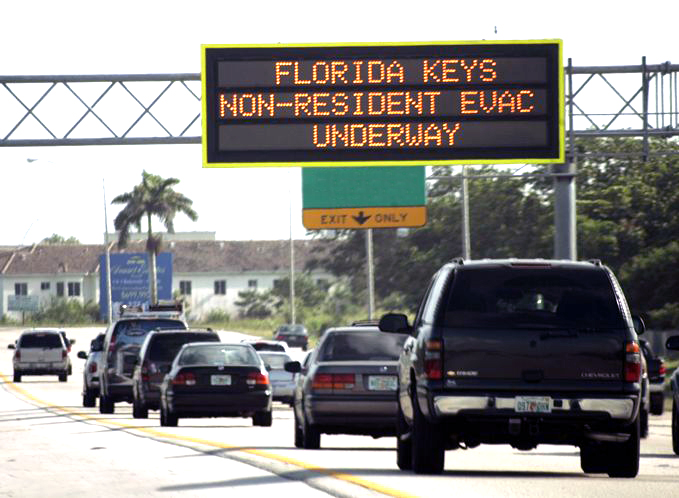By Alex Rickert, Jim McCarthy & Gwen Filosa
At a time when the Florida Keys are grappling with frequent neighborhood flooding and aging bridges, the Florida Department of Commerce (Florida Commerce), formerly known as the Department of Economic Opportunity, wants to explore modifications to hurricane evacuation models that could add up to 8,000 new building permit allocations to the island chain.
The Keys’ rumor mill went to work on Wednesday afternoon shortly after the conclusion of the Board of County Commissioners’ monthly meeting, prompting some government officials to indicate that Florida Commerce was prepared to award thousands of new allocations following the 2024 Florida state legislative session. Within hours, the hype of the original message had scaled back considerably.
“It’s an option,” Monroe County Administrator Roman Gastesi told the Keys Weekly on Wednesday. “There are a lot of options, a lot of moving parts and (Florida Commerce) want(s) to hear from us.”
Two webinars, set for Tuesday, Nov. 14 and Thursday, Nov. 16, are planned for Florida Commerce staff to “inform local governments on updates to the Hurricane Evacuation Modeling and draft results.” The current models, based on population data and a simulation of evacuation using the Keys’ roadways before a disaster event, form the basis for the “cap” on building allocations in the Keys.
According to state statutes governing the Keys as an Area of Critical State Concern, total building allocations must still allow for a complete evacuation of the Keys’ permanent residents in no more than 24 hours. Modifications of this model – upping the evacuation to 30 or 36 hours, for instance – based on 2020 census data and updated simulations, could theoretically allow for thousands of additional allocations.
At present, there are an estimated 7,950 buildable lots left in the Keys. But there are nowhere near that number of building permits, given out through the Rate of Growth Ordinance (ROGO)/Building Permit Allocation System (BPAS). At present, Marathon has just 10 allocations to give (four market rate allocations, four owner-occupied, and two affordable), and if the current distribution schedule is followed, those will run out in the summer of 2024. Islamorada has already exhausted its supply of permits, and on Nov. 9 passed a resolution to impose a moratorium on market rate BPAS applications. At present, only additional “administrative relief” allocations and two affordable housing allocations remain for the village.
Who Pays the Bill if the Keys Can’t Build?
The complete expiration of building allocations will soon open the floodgates for regulatory takings cases, a longtime cause for concern among Keys officials. Under U.S. constitutional law, these cases occur when governmental regulations – such as the ACSC statutes for the Keys – limit the use of private property to such a degree that the landowner is essentially deprived of all economically reasonable use and value of their property. It’s the plight that the owners of otherwise buildable lots who failed to secure building allocations will soon face – and it’s a massive price tag on the table for either the state or Keys governments.
In the years leading up to 2023, questions began to arise as to which entities — the state, county or local municipalities — would foot the bill in cases when those property owners were successful in court and owed damages.
In 2019, then-state Rep. Holly Merrill Raschein and then state Sen. Anitere Flores introduced legislation proposing the state be held responsible and provide half the compensation to property owners who won their cases. The other half would come from local municipalities in the Keys.
While legislation received support from all municipalities in Monroe County, bills in the House and Senate never reached the floors for a vote.
Flores, who introduced the bill in the Senate in 2019, said at the time that it would solidify a “handshake agreement” that existed for years between the state and Monroe County. The legislation followed examples set by previous takings cases in Big Pine Key in 2004, in which the county and state “split the bill” over denial of building permits. As for the 50-50 split on judgments, Flores says there’s a case that the state should bear more of the cost.
“We’re in the kind of situation because of them,” Flores told Keys Weekly in 2019. “There’s financial implications with that though, and getting a bill passed out of the legislature with a higher threshold for the state would be challenging.”
Impacts of Additional Permits are Paramount
County officials and current state Rep. Jim Mooney stressed to the Keys Weekly that next week’s webinars are simply meant for sharing information, and that state officials have yet to make any recommendations for upping evacuation times.
“That needs to be emphasized. At this point it’s data sharing,” Mooney said.
“They’re telling us they’re not going to shove anything down our throats – I even used those terms with the state,” said county administrator Roman Gastesi. “They were adamant that’s not how it’s going to work.
“They’ll explain what their findings are and ask municipalities and the county what the options are,” he added. “They range from doing nothing to the potential of having thousands of extra units if we start tweaking the evacuation times.”
Even still, the impact of additional allocations in an environmentally sensitive island chain with aging infrastructure and one major highway cannot be overstated.
That makes the first question, Gastesi said, “What can the Keys handle as far as infrastructure and roads?”
Mooney shared similar questions and concerns during an hours-long meeting with officials from Florida Commerce on Nov. 7. Mooney asked the representatives if they factored in the state of infrastructure in the Keys and what more building permits could do to the ecosystem.
“Look at the water issues we have. Saltwater intrusion is an issue,” Mooney said. “The entire design of the Florida Keys Area of Critical State Concern was to preserve the ecosystem.”
Additional allocations would unquestionably impact the real estate market in the Keys, from home and empty lot prices to the value of Transferable Building Rights (TBRs), currently worth roughly $200,000 apiece as they become increasingly scarce.
Speaking to the Weekly on Nov. 9, County Commissioner Michelle Lincoln said that while still early in the process, it’s vital for Keys residents to stay informed and monitor the ongoing discussions.
“This is just as important, if not more, than the court consolidation discussion,” she said.
Attend next week’s webinars with the links below:
Tuesday, Nov. 14, 3 p.m.
Thursday, Nov. 16, 2 p.m.























